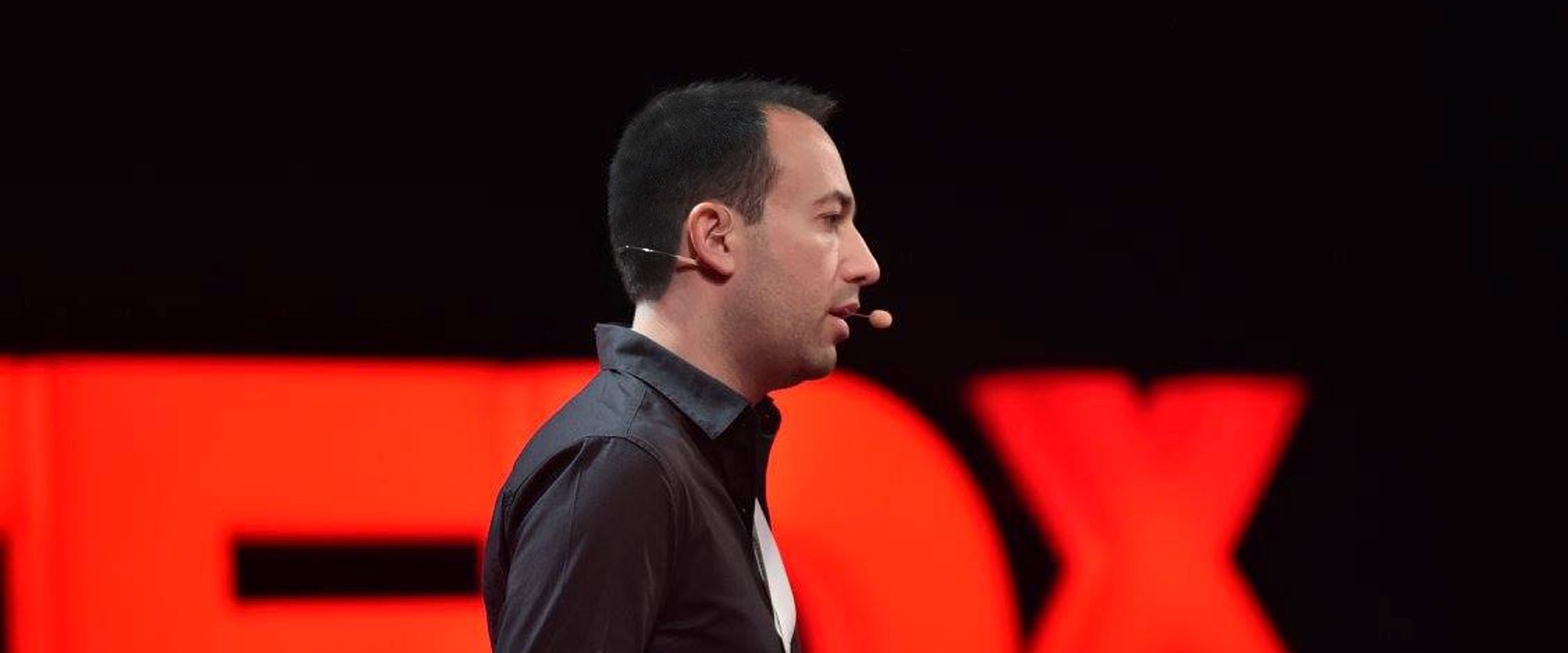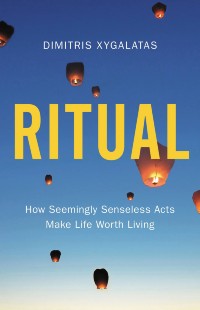Dimitris Xygalatas on Ritual

Most of us recognize the presence of ritual, whether in a religious observance, an athlete’s weird pre-competition tics, or even the cadence of our own morning ablutions. In general, most of these rituals are seen as harmless and probably a little unnecessary (or even silly). But according to cognitive anthropologist Dimitris Xygalatas, ritual often serves a positive purpose for individuals – synchronizing them with their communities or relieving their stress.
In this Social Science Bites podcast, Xygalatas defines for host David Edmonds what his research considers ritual, citing two important characteristics of ritual: causal opacity (such as rain dances not actually creating precipitation) and that the ritual matters, often greatly, to the participants. What isn’t ritual, he notes, is habit – although habits can veer into ritual/
“Utilitarian actions can become ritualized,” Xygalatas says, “and to that extent, they can be considered as rituals. So .. because I am a very avid consumer of coffee, when I get up in the morning, I always have to make a cup of coffee – [and] it always has to be in the same cup.”
Xygalatas then describes fieldwork he’s done on “high-intensity” rituals, ranging from firewalking in Spain or an “excruciating” annual religious procession in Mauritius. These efforts – part ethnography and part lab experiment – have given him unique insight into the results of jointly experienced ritual, much of which he detailed in his recent book, Ritual: How Seemingly Senseless Acts Make Life Worth Living. (In a blurb, Jane Goodall wrote the book shows “how and why our most irrational behaviors are a key driver of our success.”)
An associate professor in anthropology and psychological sciences at the University of Connecticut – where he heads the Experimental Anthropology Lab – Xygalatas also discusses the transdisciplinary scope of his work. This reflects his own roots in both anthropology and religious studies (he is a past president of the International Association for the Cognitive and Evolutionary Sciences of Religion).
To download an MP3 of this podcast, right-click HERE and save. The transcript of the conversation appears below.
For a complete listing of past Social Science Bites podcasts, click HERE. You can follow Bites on Twitter @socialscibites and David Edmonds @DavidEdmonds100.
TRANSCRIPT
David Edmonds: Tennis player Rafael Nadal takes a freezing cold shower shortly before a match, carries one racket onto the court with five in his bag, carefully places two drinking bottles just to the left of him, one behind the other, jumps at the net during the coin toss, and has numerous other rituals. It seems bizarre. Why does he do it?
Rituals are what Dimitris Xygalatas investigates. He’s an anthropologist at the University of Connecticut and author of Ritual: How Seemingly Senseless Acts Make Life Worth Living. Dimitris Xygalatas, welcome to Social Science Bites.
Dimitris Xygalatas: Hi there. It’s a pleasure to be with you.
Edmonds: We’re talking today about rituals. Tell me what is a ritual? Can you give us some examples of rituals?
Xygalatas: Of course, it’s important to define ritual, because this is a word that we use in everyday life, and a lot of the time we tend to use it very loosely. In my book, figuratively and literally, I define ritual on the basis of two key characteristics There are other structural characteristics of ritual that we can talk about, but there are two features, I think that are central to my definition. One of them is causal opacity. That means that ritual actions are different than utilitarian actions, because there is no clear connection between the actions that we undertake, and the goals that they mean to achieve — if there is a goal to begin with. Because a lot of the time, when you ask people why they perform the rituals, they just shrug and they go, “I don’t know, that’s just what we do.” But even if they do state some purpose, let’s say, “We perform this ritual to bring about rain,” then there is no causal relationship between my dancing around and water falling from the sky.
Another characteristic of ritual that is useful to distinguish it from things that we call habits, is that rituals tend to demarcate the domain of the sacred. And that means that ritual actions are important, they matter to us. And if somebody interrupts our rituals, we then get stressed, we then get upset. So they seem to be very meaningful, very important.
Edmonds: Give us some examples. When I think about rituals, I think about ones that are associated with major life events like birth, adulthood, marriage, death.
Xygalatas: There are certainly a wide range of rituals in all human societies that are associated with these key life stages. Obviously, birth and marriage and the end of life but also in, in all of our secular institutions. When we graduate from university, there’s typically a ceremony when people retire, they might throw a big party, or birthday celebrations. There are lots of rituals associated with other kinds of state functions, in the courtroom, for example, or the inauguration of a new president or prime minister, or the coronation of a king, and so on, so forth.
But there are also the kinds of rituals that we perform in our individual life. For some people, those can be culturally informed rituals, things like praying at home. For others, those can be simpler and more idiosyncratic actions. And those are the kinds of things that we sometimes call superstition, although that’s not a good term, in my opinion, because superstition is just a value-laden term that means whatever the dominant religious establishment does not approve of. But basically, when we look at individual rituals of that kind, those are things that, for example, we might perform under duress. And you see a lot of those rituals performed by athletes, by gamblers, and by all of us when we feel stressed, perhaps when we knock on wood, or we start engaging in sequences of actions that we just have to perform compulsively for no particular reason.
Edmonds: I want to come on to the athlete example later, but it’s interesting. You mentioned how vital it is that they are sacred. Every morning, I have a cup of coffee. And I guess it’s a habit, but it feels like a ritual to me. I can’t really start working until I’ve had my coffee. I enjoy the coffee, so it does have a function. But it seems like there’s a ritualistic element to my coffee drinking. Where would you categorize that?
Xygalatas: Yes. And coffee is something that commonly comes up in my discussions with people because it is a good example of how these categories — ritual and habit — can be blurred. So in my view, drinking a cup of coffee just because you do it every morning, does not in itself constitute a ritual. That will be a habit, because the direct function of that is to keep you caffeinated to boost your energy or to give you some level of nutrition if it includes milk or whatever.
But in many cases, those things become ritualized. So utilitarian actions can become ritualized, and to that extent, they can be considered as rituals. So, in my example, because I am a very avid consumer of coffee, when I get up in the morning, I always have to make a cup of coffee. It always has to be in the same cup. This is the cup you’re looking at right now, our listeners will not be able to see that. But it has to be this cup.
Edmonds: Beautiful cup.
Xygalatas: Of course, the aesthetic aspect of ritual is also very important. And I think what makes it a ritual for me is that I feel compelled to make this coffee, even if I don’t have time to drink it. So, I will make it and leave it on my countertop, and then drive to work if I’m in a hurry, but I will always stop to make this coffee. Interestingly enough, my three-and-a-half-year-old son’s children are very prone to ritualization. They love conforming and reenacting the rituals of adults — he has picked up on this. And if I drive him to school, in rare occasions where I might forget to make my coffee, he will remind me he will complain, he will say, “Daddy, cafe,” which is the Greek name for coffee.
Edmonds: So one element of your coffee drinking is that you do it every day. Does the frequency matter in a ritual?
Xygalatas: Yeah, so I mentioned at the beginning that there are other kinds of structural elements to ritual. And one of those elements that seems to be pervasive in most rituals is repetition. And repetition can happen at many levels. Most rituals are repetitive, both internally that is, they might involve the same action being done again, and again, and again. For example, when chanting on in certain Asian traditions, you might repeat this 108 times. But there’s also external repetition. And this can be sometimes very frequent. Let’s say every morning, you have your coffee ritual. Sometimes it can be as infrequent as once per generation, let’s say an annunciation ceremony, or a graduation, or a wedding, or a funeral. There’s always this element of repetition to ritual.
Edmonds: What happens if your son held a gun to your head and said, “You will drink this every morning?” I’m wondering whether it matters that most rituals are voluntarily engaged in is that a necessary component of a ritual? Or could there be rituals which are compulsory to participate in?
Xygalatas: There are a lot of rituals that are compulsory, usually not with the sense that somebody holds a gun to your head, but in the sense that they are culturally normative. And perhaps most of our cultural rituals are like that. We don’t tend to think about this very much. But for the vast majority of individuals, the first time they engage, let’s say, in a religious ceremony, or in a state ceremony, a secular one, it’s not because they’re motivated by the ideological framework that surrounds it. So, when you’re 6, it’s not because you’re a Christian, that you go to Mass, it’s because your parents take you to Mass by doing this ritual over and over and over and over again, you begin to attribute importance to this. A lot of the time, we might rebel against this. And for me, for example, growing up in Greece, we had mandatory morning prayer every day, and I was always trying to escape to get out of it. But in many contexts, this repetition, unless it becomes really imposed on you, it might bring a sense of community, the action itself might reinforce the sense of motivation in your mind.
Edmonds: So that touches upon something I wanted to get on. We’ve described some of the elements of what a ritual is, and I want to move on to what the function of rituals are. We’ve recorded one other interview on rituals with Harvey Whitehouse at Oxford, and people can listen to that — it’s available on the website. And he talks about how rituals help bond people together, help them cohere. And you found the same effect. Can you tell us a bit about your Mauritius fieldwork?
Xygalatas: Yes. So, the reason I went to Mauritius, and as a matter of fact, Harvey Whitehouse, whom you mentioned, was my doctoral advisor. And the reason I went at the time to Belfast to study with him was because we had a shared interest in high-intensity rituals. So, my interest in high-intensity rituals after having studied firewalking rituals in Europe, for my doctoral work, I began looking for a place where I could find even more intense rituals. And I ended up doing fieldwork in Mauritius where I’ve been working for the last 15 years. And I was precisely interested in that question that he brought up: Do rituals, indeed, promote social cohesion.
I had done some research before going to Mauritius that showed, for example, that when people get together in these highly arousing collective ceremonies, their effective responses begin to align. That means that in that context, their heart rates began to synchronize. So, this was some indication to me that that feeling that people describe that when they come together to enact those rituals, they feel like one that there was some truth to that, and there was a component to that, that we could actually measure experimentally.
And after doing this, I began to wonder, OK, does that translate into any kind of behavioral outcomes? Can we see that these people become more prosocial? Other than what they’re feeling inside their bodies? And that’s the question that brought me to Mauritius. And in that context, I built my study around a ritual that was that I felt provided all these naturally occurring conditions to study this. This is one of the most extraordinary rituals that I’ve ever witnessed. It is one of the most painful rituals in the world. And it’s also one of the most widespread because it’s practiced wherever you have members of the Tamil diaspora and by other Hindus all around the world. And what happens to this ritual is that people embark in this very long procession that in Mauritius happens to be the middle of the summer on a tropical island. So it’s excruciatingly hot. And on that procession, they carry these very large structures. They’re miniature strains, and they’re decorated with flowers and peacock feathers, and they are connected to mythological narratives about the Lord Murugan. And they will carry these structures for the better part of a day. And while they do that their body is pierced with needles and hooks and skewers. And some of those hooks they drag these chariots, by the skin of their back. We measured the number of needles in their bodies, and some people can have up to 600. It’s an excruciating festival. Some of them have skewers the size of broomsticks through their cheeks, so their peers by whom they are pierced by their family members, and the priests who are helping them prepare for this ritual.
And eventually, after all these hardships, they reach the temple of Murugan, which in that context is located on top of a hill. So, they have to climb 242 steps to get there carrying those large structures. It’s really an extraordinary feat of endurance taking part in this ritual.
So, in that context, we were able to compare members of the same community who worshiped at the same temple and took place at the same festival at different times. We could look at people when they took part in the kavadi ritual, and compare that to when they were taking part in a collective prayer at the same temple that involve very low levels of physiological arousal. And we also compared this to people outside of any ritual context. And what we did is that we set up a charity task, a charity to the local community, and we had Mauritian research assistants administer that task. So, people didn’t know that it was us suggesting that they donate money to the charity, and we monitor 30 levels. And we found that after taking part in this ritual, people were three times more likely to give money to charity, participating in the low-key ritual also increased donations, but participating in the high arousal, the very painful one was off the charts. And in fact, we found a linear relationship between the pain they experienced and the amount of money they donated.
Edmonds: What about onlookers to that. Was it just the people who had the needles and had to carry this extraordinary edifice who ended up giving more to charity? Or was it people just observing them?
Xygalatas: This was one of the most interesting parts of the study for me, because in the Spanish study, the heart rate study that I mentioned, that was in the context of a Spanish firewalking ritual, we found that people’s heart rates were synchronized, and that spread beyond the active firewalkers to the other members of their community. And the closer they were to somebody socially or genetically, the greater that synchrony. So, outsiders who would come towards us curious tourists didn’t experience that effect. And that same finding translated at the behavioral level into the Mauritian study, because there we found that on the day of kavadi, even the family members of these people who joined the procession and walked alongside them — so they suffered vicariously because they had no needles in their bodies, that were not carrying these large objects. And they were able to drink water, and so on, so forth — they too saw the same effects on pro-social behavior. So there to give three times as much similar levels to that of the people who suffer.
Edmonds: And you think that occurs through a sense of community that people feel when they participate or observe these extraordinary rituals.
Xygalatas: It does. I, in fact, in that context, and Mauritius, this is something that as an ethnographer, I could see this with my own eyes. So, from my observations, that’s what I could see. So, on the day of kavadi, which is a national holiday, people go out in the streets, and they offer fruits and water to everybody walking along the procession, and they bring pots of water or hoses, and they, they help the pilgrims soothe their feet, because they’re walking barefoot on the burning asphalt. And then later, people volunteer at the temple, they volunteer with their time and their money, they bring food and they cook and they share their meals with everybody. So, you can really see that on that day, people become more pro-social, but for me, it was more of a question of OK, can we quantify this? And can we measure this in any kind of systematic way?
Edmonds: So that’s the effect of rituals on bonding, social cohesion. Your work has focused on another beneficial aspects of ritual, which is on reducing stress. Tell us how it might do that.
Xygalatas: That was a very important aspect of ritual that I think also speaks to its evolutionary origins, because in order for us to engage in those group cultural rituals, ritual has to be appealing to us as individuals. And to understand this we have to look at the origins of ritualization. This is something we share with many other species, ritual is pervasive throughout the animal kingdom. And in many contexts, it’s been hypothesized that it helps the organism deal with anxiety.
The first person to translate this into an anthropological argument that is typically attributed to an anthropologist called Bronislaw Malinowski, who did his fieldwork in the Trobriand Islands in the Southwest Pacific. He noticed that the local fishermen, when they went out to fish in the open sea — which was very dangerous, and they had small, flimsy canoes, and there were sharks, and there were in waves, and you never knew if we were going to bring anything back, or if you’re going to come back — they performed a great number of rituals associated with the building of canoes, the preparation for fishing, the fishing itself, and coming back and everything else. But the same people when they went fishing into the shallow waters of the lagoon, there, they used a poisonous route to stun the fish and then scoop them up. So it was very easy. And it was not an overwhelming task, but it was perfectly safe. And there were no rituals when they were doing this.
So he proposed that these rituals might serve a function for these people to help them deal with anxiety. But for a very long time, this had not been tested experimentally. So, my colleagues and I were among the first teams to do that. Then we did this in a series of studies. For example, in the laboratory, we brought people in, and we stretch them up, and we measure their anxiety and their physiology, as well as their self-reports.
Edmonds: You stressed them how?
Xygalatas: So one of the most stressful things you can get people to do is engage in public speaking, especially when they’re unprepared. And that’s exactly the task we set up for them, we told them, they would have to deliver a speech on an object in front of a panel of art critics that really stresses people up, we could see this in their heart rates, we could see it in their self-reports. And then we use motion sensors to look at their behavior. And this was associated with cleaning that object of art. And what we saw is that the more stressed they were, the more ritualistic their behaviors became. That means that they were more repetitive, and more rigid, and more patterned, which is similar to what we see in all kinds of rituals.
So starting from this finding, we now went to the field to Mauritius again. And we looked at a group of women as they were going into the temple to perform their usual prayers, we had random assignment, but this was in a real-life context. So, either they went into the temple, or they went into another room, which was not associated with any kind of religion, it was essentially a lab a place that we had rented. And in one case, they performed rituals. And in the other case, they just sat down for the equivalent amount of time. And we found that after performing those rituals, their heart rate variability increased, which means that they were better able to cope with anxiety. And once more, we see this both in their self reports, they feel less stressed. And we see in their bodies.
Edmonds: You mentioned athletes earlier, you’ve got this wonderful example, in your work of rituals that athletes perform. And you mentioned the tennis player, Rafael Nadal who has an incredible number of rituals.
Xygalatas: Yes, and here’s what the only one. Nadal was an interesting case to describe. I think in my book, I dedicate a whole page on the ritual that he does before and during his game. But he’s in no way unique in that. And in fact, there are studies that show that elite athletes tend to have more rituals. From a naïve perspective, you might think that the better you are, the more you can rely on your own skills, and the less you would have to rely on rituals, but in fact, we’re seeing the opposite. And I believe that’s because elite athletes face higher stakes. And this is something we see in other domains. For example, among gamblers, the higher the stakes, the more ritual as they gamble. In fact, gamblers are notorious for developing all of these elaborate rituals and superstitions.
Edmonds: So Nadal bounces the ball a certain number of times … Except he has many rituals. Suppose he were to do away with those rituals Do you think his performance would suffer?
Xygalatas: I think it would disturb him, I think he would feel annoyed, stressed by this. And as a result, his performance might suffer. In fact, there are some studies that looked at baseball and basketball players. And they did exactly that. They disturbed them from performing their usual rituals. And they did find that performance dropped.
And we can explain this in two ways. So first of all, when you perform a ritual, you get a sense of control. This is related to how our brain processes the world around us. Our brain constantly makes predictions all the time, even before I finished my sentence, your brain has a prediction about what my next word is going to be. And if it’s not what it expects, we can see that in in the brain that we feel surprised. As a result of that when we have low predictive capacities, when there’s uncertainty, in other words, we feel stressed. Think of situations like expecting the results of a medical test that might show something terrible, or being in a war zone where you don’t know when the next one was going to drop, or for that matter competing in a high stakes sporting event or the casino. So uncertainty creates anxiety. And one way of coping with anxiety is to engage in patterns that are very repetitive, and that makes them very predictable. So if ritual is anything, it is structure, it is predictability. When I engage in a ritual, I know exactly what to do, I know exactly when and how to do it. And that gives my brain a sense of control.
And it doesn’t really matter whether this control does not translate into other domains. All that matters is that it helps me reduce anxiety and get back to work, essentially. And that’s what we’re seeing with these athletes.
Edmonds: It’s a way of dealing with an uncertain world.
Xygalatas: Yes.
Edmonds: You describe yourself as an anthropologist, but it seems to me you could equally call yourself a psychologist. What makes you one rather than the other?
Xygalatas: That’s a good question. And in fact, at the University of Connecticut, I’m affiliated with two departments, anthropology and psychology, as well as the cognitive science program. Typically, we think of what makes you one over the other is probably the methods that they use. And this is something that since I was a graduate student, I found it disturbing that we get so used to the kinds of methods that we were taught, we see everything around us, you know, as the saying goes as a nail, because all we have is a hammer. But not all problems can be solved by nailing and hammering.
Very often in the social sciences, we’ll see that we ask the exact same questions between disciplines. But we go about trying to answer those questions in very different ways. Either we’re accustomed to bringing people into a lab and doing experiments where we have a very high degree of control, or we go into a field situation, a field setting, and we engage in participant observation, and we provide qualitative findings.
And both of these parts of the story are very important. But it’s very rare that the same individuals or even the same teams of individuals, try to combine the two. And that’s exactly what I’m trying to do, what my research tries to do. The idea is that, instead of taking people out of context and moving them into a sterilized lab, for some things, it’s perfectly fine. But when you’re looking at things that are surrounded by meaning and have to be performed in specific locations, and with large groups of people, you can no longer do that. Instead of doing that, I decided to bring the lab into the field. So to try to go into real-life situations that temples and football stadiums and wherever life happens, and bringing some level of measurement to corroborate my more qualitative findings.
Edmonds: So both psychology and anthropology can speak to each other. In that regard. Are there other social sciences, that you could co-opt in your work?
Xygalatas: Oh, yes, absolutely. So a lot of my work draws from the biological sciences. So I look into people’s physiology, I look into people hormones, some of the inspiration from my work has come from sociological theories, like those of Emile Durkheim. Obviously, as anthropologists, we also draw from the historical sciences in order to explain some of the current cultural arrangements that we see in our fields, and so on and so forth.
Edmonds: I take it from what we’ve been talking about so far that you recommend that humans adopt and cultivate rituals. Beyond the daily cup of coffee you have, are there any particular rituals that you have that you would like to share with us?
Xygalatas: Through my studies of rituals, I have become more conscious about implementing those rituals. There are a lot of things that I’ve tried to do. For example, in my lab, we have a series of rituals. And we always start and finish with those rituals. So we start by talking about everyone’s highlights over the past week, we typically end with coffee. During the holiday period … so growing up, I never felt the need to have a Christmas tree. My wife and I never had a Christmas tree up. But now that we have a young child, we’ve decided that we want him to feel that he’s part of some family tradition. And it doesn’t have to be a Christian tradition. It’s just a holiday tradition. The flamboyance of the Christmas tree is one of the most common ways that we highlight those family traditions with colors and bells and whistles. And although I’m not an American, since I moved to this country, unless I’m traveling on Thanksgiving, I will embrace those rituals. I will cook that turkey I will spend the entire day. And sometimes we might during COVID, for example, we would have virtual celebrations with our families. My family is in Greece, my wife’s family is in Spain. So we bring them together virtually to celebrate those same traditions, and so on so forth.
Edmonds: Dimistris Xygalatas, I’ve really enjoyed talking to you.
Xygalatas: Thank you very much indeed. It’s been a pleasure. Thank you.



























































































